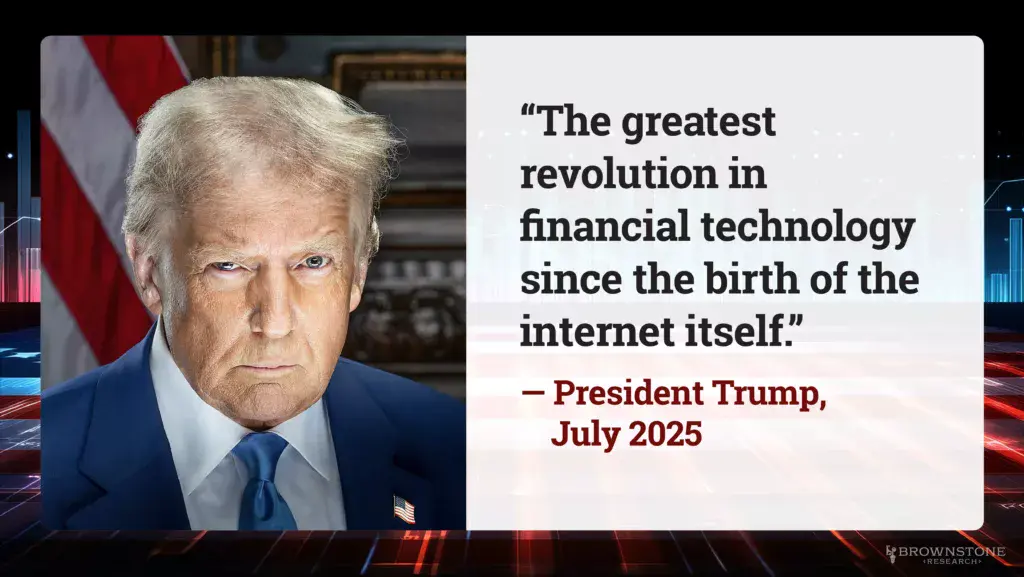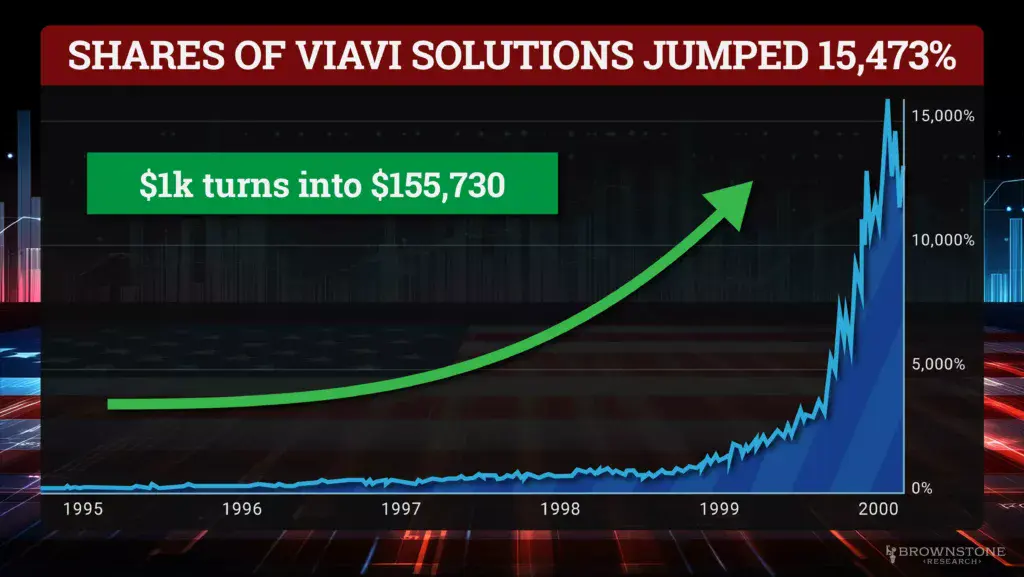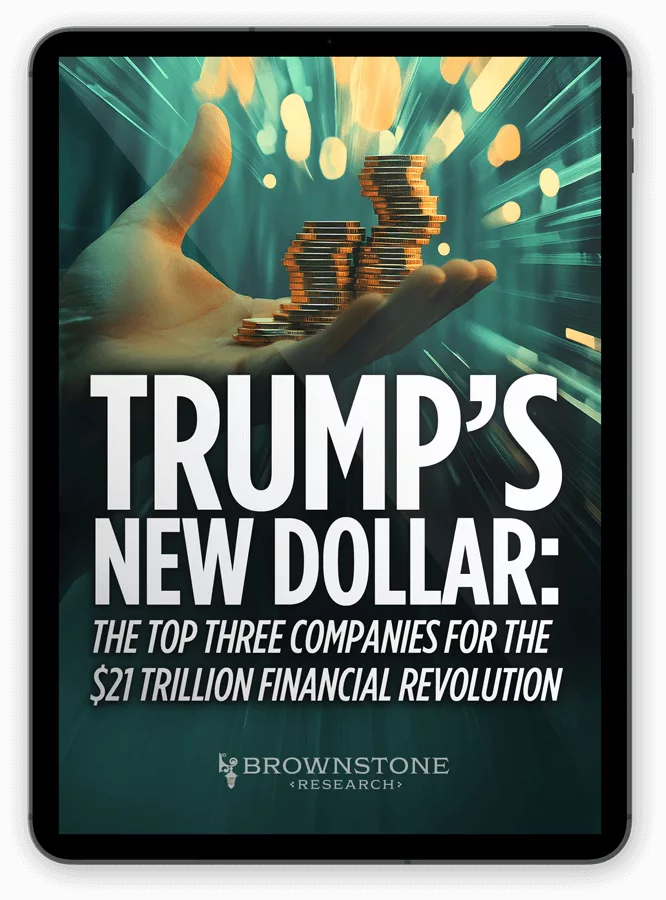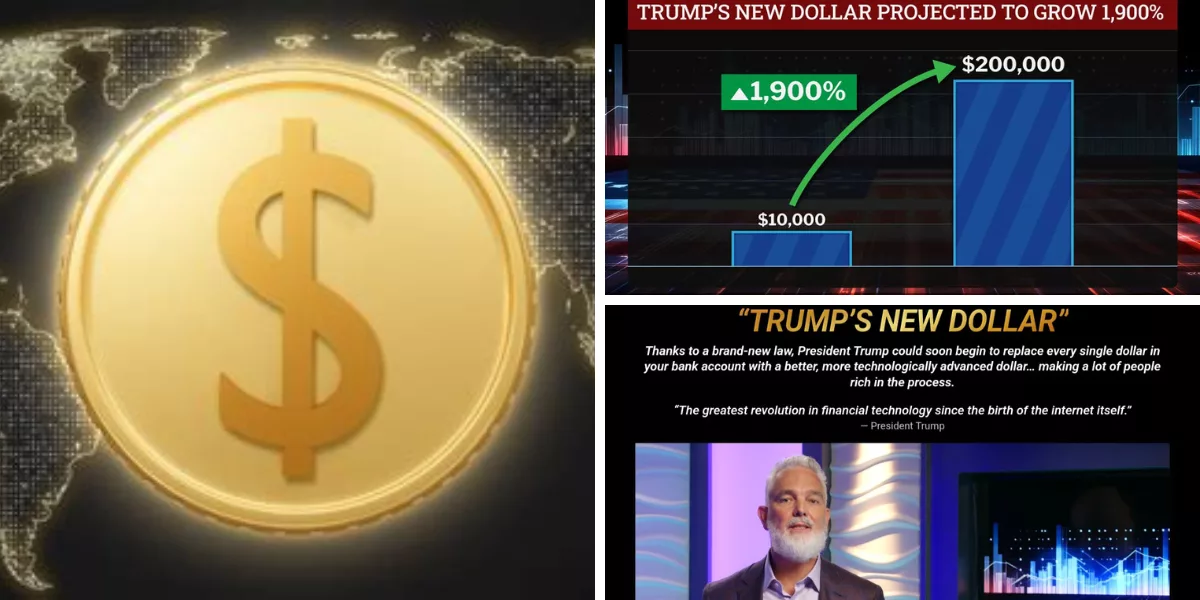It finally happened.
The legal framework for a new U.S. currency, which Jeff Brown calls “Trump’s NEW dollar” has been signed into law, and its creating a huge opportunity for everyday Americans.
The Teaser
Is this a legit new legal tender currency or just a new form of payment?

Former tech exec and enthusiast Jeff Brown has been early spotting some big technological shifts in the past, from Bitcoin in 2015 to Nvidia in 2017.
We previously did a deeper dive on Jeff and also reviewed some of his more recent calls, like his AI Superweapon Stocks to turn $15,000 into $3 million.
If you have money and assets tied to the U.S. dollar, this teaser is worth a gander.
But perhaps we're not taking it seriously enough, because Jeff adds:
“Every American should prepare for what I believe will be the biggest change to our financial system in 54 years.”
President Trump himself has called it:

However, the clue that gave away the plot was this one:
“Trump's New Dollar” is a better version of the U.S. dollar for payments and settlements.
Now we know that he can only be talking about stablecoins.
So, it's not a new dollar, but rather a digital dollar that is pegged to USD on a 1:1 basis.
Stablecoins have been around almost as long as crypto has and were initially developed as an easy way to park money on (block)chain before buying other cryptocurrencies.
Now, since the traditional banking system has not innovated or evolved since the Clinton administration, stablecoins have grown into a $255 billion global market, and are used in all kinds of transactions.
Another Historic Meltup
Jeff likens Trump's GENIUS Act, establing a regulatory framework for stablecoins to the 1996 Telecom Act, which laid the groundwork for the development of the internet.
The aftermath of that, for those of us old enough to remember, was a historic melt-up in the small companies that were building the web's infrastructure.
Jeff has the receipts to prove it too.
For example, had we invested $1,000 in shares of network testing company Viavi Solutions, we could have cashed out more than $155,000.

The same amount would have been good for almost $200,000 in Veritas Software over the span of just five years.

As these new digital dollars begin to go mainstream, Jeff believes shares of some companies with the expertise to build blockchain infrastructure will skyrocket to new highs just the same.
The Pitch
Their names are revealed only in a brand-new report called: Trump’s New Dollar: The Top Three Companies for the $21 Trillion Financial Revolution

All we need to do is give Jeff's monthly research service, The Near Future Report, a try for the next 60 days.
The regular price for a one-year membership is $499, but Jeff is lowering this to $179 with a 60-day money-back guarantee, for a limited time.
The New Payment Standard
In 1944, the Bretton Woods agreement established the U.S. dollar as the global reserve currency.
America would not have become an economic superpower without that agreement and now, more than 80 years later, a new type of digital Bretton Woods agreement has emerged.
Just like the original Bretton Woods required nations to hold U.S. dollars. Issuers of stablecoins will have to hold U.S. dollars and short-term Treasury bonds.
However, unlike the first go-around, no coercion will be needed to adopt “Trump's New Dollar” for two reasons:
First, stablecoins are not issued by central banks. They are issued by private entities like fintech companies, making their use entirely voluntary and in turn, more trustworthy.
Second, stablecoin transaction costs are a fraction of credit card transactions, wire transfers, and other fiat payments. Not to mention that settlements are nearly instantaneous instead of the typical 2-3 business days.
It's a better dollar, which is why adoption is exploding.
Visa has stated:
Every institution that moves money will need a stablecoin strategy
Major companies like Shopify have already begun to accept stablecoins as a form of payment.
Payment giants Visa, Mastercard, and Stripe are also getting involved.
Even the great state of Wyoming has launched its own stablecoin, which is how you know things are serious.
Stablecoins appear poised to become the new payment standard and three companies are perfectly positioned to cash in on this explosive new trend.
Trump's New Dollar Companies
It's only near the end of Jeff's presentation, which thankfully had a transcript, that he drops any hints about his picks.
The first one we get is that:
He's expecting a big announcement from a company as soon as October 28th that will expose Trump’s new dollar to 434 million consumers and businesses around the world.
The date of October 28th could be a scheduled event, while the 434 million figure hints at the number of users the business has around the world.
Based on this, Jeff's first pick is PayPal Holdings Inc. (Nasdaq: PYPL).
PayPal's Q3 earnings call is scheduled for October 28th and it has exactly 434 million active individual and merchant accounts as of June.
No other clues are provided about the last two picks, other than that “we can buy them using any regular brokerage account,” which does about as much good as pointing out that the sky is blue.
However, we can project a little and point out some other stablecoin-related stocks, starting with recently IPO'ed Circle Internet Group (NYSE: CRCL).
The company is the only publicly-traded issuer of a major stablecoin (USDC).
Coinbase Global Inc. (Nasdaq: COIN) is abother. It is the largest U.S. based crypto exchange and it also owns a minority stake in Circle.
It's slim pickings when it comes to stocks, but fast, programmable blockchains that stablecoins run on are still public, albeit in coin form, with the likes of Ethereum (ETH), Solana (SOL), Avalanche (AVAX), TRON (TRX), and BNB Chain (BNB), all available to buy via Coinbase.
In the end, will any of these set us up for massive gains?
Turn $10,000 into $200,000?
The profit claim comes from the optimistic projected market growth of 1,900% by 2030.
For some context, such projected growth is three times faster than artificial intelligence.
To be fair, the figure isn't that far off the nearly 1,000% growth of the stablecoin market from 2019 to the present and now that stablecoins are a legal form of payment, and incentivized, usage will pick up.
The $700 billion international remittance and $1 quadrillion cross-border payments markets have been begging for disruption and this could be it.
PayPal is well-positioned to help facilitate this shake up with it's existing distribution and recently launched stablecoin, PYUSD.
The fintech company is already growing by about 5% per year, but this should accelerate in the years to come and it trades for only 12x next year's projected earnings, meaning it's potential growth is nowhere near factored in.
The projections in Jeff's teaser may be overzealous, but the convenience, speed, and lower costs of digital dollars backed by real assets will make them the dominant currency form in the future.
Love it, hate it, or indifferent, wealth will be created from this “new dollar” and we can make our share by investing in the building blocks now.
Quick Recap & Conclusion
- The legal framework for a new U.S. currency has now been signed into law. Jeff Brown calls it “Trump’s NEW dollar” and its creating a huge opportunity for everyday Americans.
- Jeff is referring to the recently signed GENIUS Act, which regulates stablecoins backed 1:1 with assets such as USD and Treasuries.
- The opportunity is in companies building the blockchain infrastructure that stablecoins run on, and Jeff reveals the name of three in a brand-new report called Trump’s New Dollar: The Top Three Companies for the $21 Trillion Financial Revolution. It takes a subscription to the Near Future Report newsletter and $179 upfront to get it.
- Jeff played things cool, dropping next to no clues, as usual, but we were still able to reveal his first pick for free as PayPal Holdings Inc. (Nasdaq: PYPL) and threw out some possibilities for his other two picks.
- If you can save people time, money, or make their lives easier in some way, you will be rewarded. Stablecoins have at least two of these three features and early shareholders of issuers like PayPal and blockchain infrastructure providers will reap the rewards.
Have you purchased or used a stablecoin? Tell us about your experience in the comments.

